Deborah Halverson's Blog, page 2
August 9, 2022
The Coolness of Editing Bayside

Today I edited bayside at San Diego Bay, near Maritime Museum of San Diego. I enjoyed my view of Californian (the official tall ship of the state of California), and the San Salvador replica (the original first sailed into San Diego in 1542). The main museum is 1898 steam ferryboat Berkeley from San Francisco Bay. The manuscript I edited has zero to do with bays, ferries, tall ships, or anything else I saw from my comfy bleacher seat-on-a-bench — I was just really hot at my house and wanted a cool breeze off the water.
About the Maritime Museum: The Maritime Museum of San Diego enjoys a worldwide reputation for excellence in restoring, maintaining and operating historic vessels. The museum has one of the world’s finest collections of historic ships, including the world’s oldest active ship Star of India. Our collection of ships and exhibits are available for public tours. Named one of the worldwide top three Maritime Museums.
July 13, 2022
Feeling Spacey Today
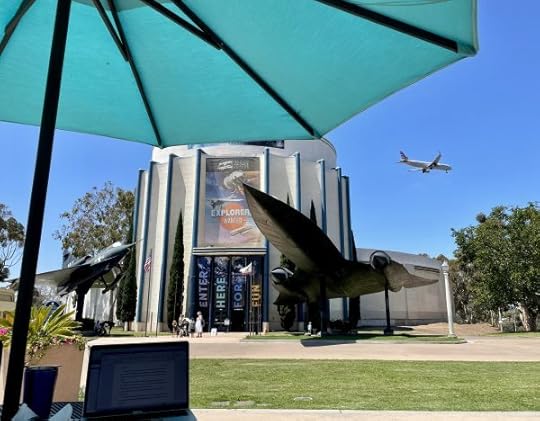
Have you seen the first images from NASA’s James Webb Space Telescope? They get my imagination all whirled up as I try to wrap my head around the depths of space. Inspired, I set up my mobile editing office at the San Diego Air & Space Museum in Balboa Park today. I get a kick out of the plane art out front.
If you don’t know, this fabulous museum is an affiliate of the Smithsonian Institution. It houses a collection of historic aircraft and spacecraft, including a flight-worthy replica of Lindbergh’s “Spirit of St. Louis” and the actual Apollo 9 Command Module. Lots of hands-on things for kids. I’ve spent many hours inside the museum with my sons. Today, I enjoyed the sunshine outside, with the planes cruising overhead. I suppose that would be noisy to some, but I lived under that flight path for 4.5 yrs so the noise is nothing to me.
What can be your inspiration today?
Writing, like life itself, is a voyage of discovery.
Henry Miller

June 2, 2022
Podcast Alert: Deborah on “How Writers Write”
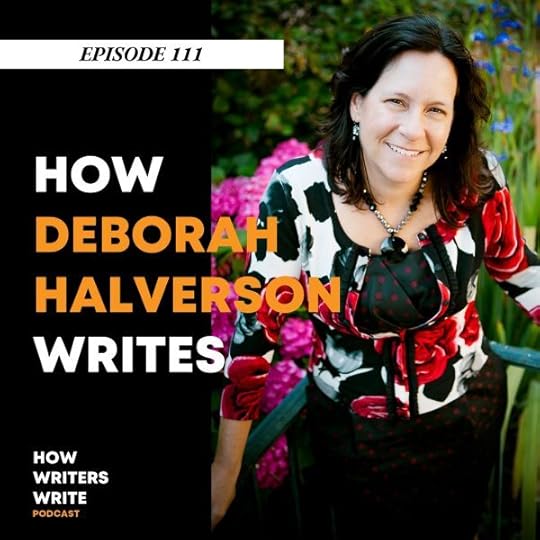
I love the “How Writer Write” podcast. Host Brian Murphy excels at leading great discussionabout writing practice and process. We get into that in this episode, plus we dig into the question “What makes a story ‘Young Adult’?” and I get to talk about what it’s like to think like an editor. It’s a fabulous discussion. To listen to the podcast: Apple: https://apple.co/3m9kAhZ; Spotify: https://spoti.fi/3m8rpQR
December 6, 2021
Deborah Auctioning Picture Book Edit & Call for #WeNeedDiverseBooks

I’m honored to be contributing to the #WeNeedDiverseBooks Campaign by offering a picture book edit and phone call with me in their Holiday Auction. Visit https://bit.ly/3HZPItU to bid on this and check out all the other offerings.
The Holiday Auction ends 10pm Eastern 12/6/21.
July 4, 2021
Can You Eat 76 Hot Dogs in 10 Minutes?
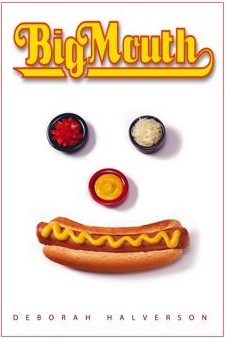
Joey Chestnut can. Oh, and don’t forget the 76 buns — because he ate those, too. Today was the Nathan’s Famous International Hot Dog Eating Championship, held every 4th of July. When I wrote BIG MOUTH, a middle grade novel about a boy who aspires to be the world’s greatest competitive eater, the Nathan’s Famous contest record was 53-1/2 hot dogs and buns in 12 minutes, by Takeru Kobayashi. Joey Chestnut’s accomplishment today trounces his own record, and makes him the astounding 14-time winner of the contest. Is there a limit??? I guess we’ll find out next year. Trust me, I’ll be watching.
January 27, 2021
How to Write a Great Query Letter
Every writer seeking traditional publication will submit their project to agents and/or editors at some point. Writing that submission email can be stressful. You want to get it right, right? In this post, I break down the parts of a query letter and talk you through each one. At the end, I’ve included a sample query letter, plus links for even more information about writing the query and putting together a successful submission package.
The email you’ll send to an editor or agent along with your sample pages (or, in the case of a picture book, your full manuscript) is called a “query letter.” The query letter delivers the hook that’ll make the agent/editor sit up and take notice; presents the distinguishing themes, conflict, and characters or other details; and presents your credentials as a writer—or any other pertinent information, like how your expertise at restoring WWII tanks led you to write that WWII historical YA thriller. The letter does all this in three paragraphs. (Okay, sometimes four.)
IMPORTANT: A successful query letter’s goal is NOT to summarize your book, or even to inform the agent/editor who reads it. The goal is to drive that agent/editor to the manuscript you’re submitting.
The core structure of three-paragraph letter has you leading with a hook (also called a logline or an elevator pitch), then swooping in with a pitch that’s meant to provoke action (that action being reading the manuscript/sample pages), and then closing with the business stuff—the word count, your credentials, etc.
In more detail:
PARAGRAPH 1 states the hook for your manuscript and indicates why you chose that editor or agents. Intrigue them with your concept in a nutshell. Perhaps include a notable item about you or the manuscript, such as a conference WIP award.PARAGRAPH 2 expands on the themes and general journey of the main character, and positions the project in the marketplace. Some mini-summary, but just enough to set the stage for the statement of conflict and to convey the core universal themes. Stress the elements that make this appealing to your target reader and that fit into the genre, and the fresh angle on the topic. Be concise! There’s plenty of room for detail in your synopsis, which most agents and editors require as part of the submission package.PARAGRAPH 3 is the closing. It’s your time to toot your horn, stating your credentials, citing your writing history or pertinent facts about why you’re right to tell this particular tale. If you’ve self-published this or other books, mention that here. Include the word count and any writing group membership.SOMETIMES YOU NEED AN EXTRA MIDDLE PARAGRAPH: This is for unique information the editor/agent may not know but should know in order to understand a special market need or audience potential for the book. Example: stats about the decreasing age for the onset of puberty in girls for a pitch about a puberty-related book for girls ages seven through ten. (Warning: Avoid being too ambitious about marketing. This isn’t the time to get into that.) If you’ve got comparative titles, mention those here. You don’t NEED “comps,” though. Agents and publishers who require comps will note it in their submission guidelines, posted on their websites. This extra paragraph usually sits nicely between the second paragraph and the closing credentials paragraph of the query letter.I hope this quick explainer has been helpful to you. I dedicate an entire chapter of Writing Young Adult Fiction For Dummies to the nuts and bolts of writing a great query letter, along with crafting and polishing all the pieces of a strong submission package and putting together your list of agents and publishers. That chapters includes a step-by-step for writing a hook/logline.
~ Writing Young Adult Fiction For Dummies covers every aspect of publishing, from idea to promoting your published book. Click here for some quick tips from the book for creating a youthful narrative voice, writing convincing teen dialogue, and evaluating character and plot.~
Below is an example of a query letter, with all the above pieces in place. I wish you the best in your quest for representation and/or publication. Happy writing!
EXAMPLE QUERY LETTER…
Dear Editor/Agent:
What do you give a girl who has everything? Camo, KP, and an education in real life. In my contemporary YA novel Party Girl Goes A.W.O.L., a spoiled teen parties one time too many and gets shipped off to her grandfather’s iron-fisted alma mater: George S. Patton Military Academy. Given your deep list of contemporary YA authors, I’d like to send you Roxy’s story.
Seventeen-year-old Roxy Monroe is spoiled rotten. She’s got hot clothes, a hot car, and of course the hottest guy at school. When her constant partying threatens her chances of graduating high school, she’s sentenced to the only school her parents think can tame her: a hardcore military academy. Now Roxy’s life is Reveille at daybreak, forced marches, and classmates who think camouflage is cool and stuck-up party girls are good for just one thing—pranks. Roxy vows to break out or die trying. But when her rules-crazy roommate gets caught up in the breakout and risks everything for Roxy’s safety, Roxy sees the human beyond the uniform—and takes a hard look at herself. Celebrating friendship and the ability to find common ground, Party Girl Goes A.W.O.L. offers a lighthearted, girl-power spin to the popular rich-girl-comeuppance tale.
I have an MFA in writing from X and have taught high school English for ten years. Party Girl Goes A.W.O.L. would be my debut novel. I’m a member of SCBWI. The manuscript is complete at 80,000 words. Thank you for your consideration.
All best,
A. A. Author
SCBWI member
Website url
Phone number, Email address
*Alternate third paragraph if you’re previously self-published: I’ve self-published two young adult novels featuring strong females. I’d very much like to grow my career with a publisher and hope you see potential in Party Girl Goes A.W.O.L. to do that. At 80,000 words, Party Girl Goes A.W.O.L. can stand alone or be developed into a series. Thank you for your consideration.
January 16, 2021
Predicting a Uniquely Unpredictable 2021
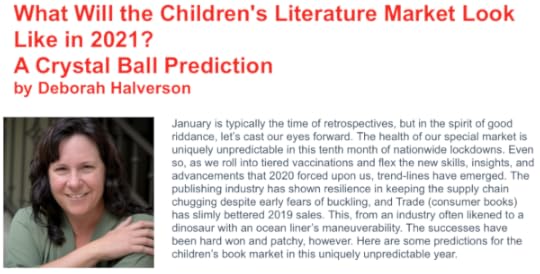
I shared some predictions for children’s literature market in the January edition of SCBWI INSIGHT, a monthly enewsletter for members of the Society of Children’s Books Writers and Illustrators. INSIGHT features current children’s book hot topics, helpful hints, exclusive interviews and monthly contests. When talking about likelihoods for 2021, emerging trend-lines are intriguing to extend forward. I appreciated the challenge and opportunity to do so.
January is typically the time of retrospectives, but in the spirit of good riddance, let’s cast our eyes forward. The health of our special market is uniquely unpredictable in this tenth month of nationwide lockdowns. Even so, as we roll into tiered vaccinations and flex the new skills, insights, and advancements that 2020 forced upon us, trend-lines have emerged. The publishing industry has shown resilience in keeping the supply chain chugging despite early fears of buckling, and Trade (consumer books) has slimly bettered 2019 sales. This, from an industry often likened to a dinosaur with an ocean liner’s maneuverability. The successes have been hard won and patchy, however. Here are some predictions for the children’s book market in this uniquely unpredictable year….
Deborah Halverson, SCBWI INSIGHT, January 2021
November 25, 2020
A Book with Benefits

It was my honor to edit the Purple Project’s picture book PENNY’S ADVENTURES IN SAN DIEGO. Sales benefit victims of domestic violence and abuse. For this book, thirteen San Diego County mayors and a deputy mayor each penned a chapter of a story about a kind-hearted purple butterfly named Penny visiting their respective cities and doing a good deed.
The book just got a lovely write-up in the San Diego Union-Tribune, and I got a fun little mention: “Deborah Halverson, an editor and publishing consultant, wrote chapter transitions and edited the book at no cost, while Danielle Ramirez created colorful illustrations.”
The 85-page illustrated book, “Penny’s Adventure in San Diego,” is now available for pre-order for $25 and due for release in early December.
October 12, 2020
My New Class for KidLit Writers!
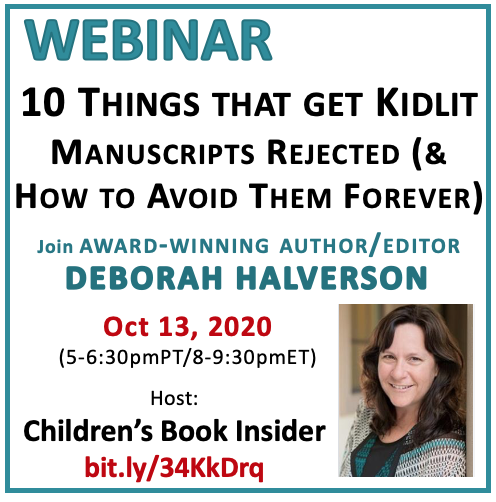
I’m honored to have created a new class for Children’s Book Insider: “10 Things That Get Kidlit Manuscripts Rejected – and How to Avoid Them.” It will be 90 minutes of deep-digging writing tools for writers of picture books, chapter books, middle grade and young adult — fiction and nonfiction. I’ve got you all covered — and well. ?
The class will be live online Tuesday, Oct 13, 2020, with lifetime on-demand rewatching. Jump on over to the class page for the full details and sign-up.
Children’s Book Insider is a place to take classes on all aspects of writing and publishing books for young readers. If you haven’t checked out its offerings, it’ll be well worth your time to do so now.
June 28, 2020
Texting in Novels – It’s a Thing
With texting behavior like that, texting is going to show up in our novels. But while there are rules for how to format dialogue, no rules exist for texts. What’s a writer to do? I tackled that issue in my post today on DearEditor.com, after a writer posed the question to me:
Dear Editor…
How do you suggest presenting texts in print? I looked at Julie Buxbaum’s book HOPE AND OTHER PUNCH LINES. She bolds the names and indents the texts the same amount as the indent at the beginning of regular paragraphs. What do you think?
Sincerely,
Want to Get It Right
I replied that with clarity and “voice” should be your guides. Then I went deep into some nuances writers should be aware of in so that they can use texts to reveal and build their characters just as they do with regular dialogue. If you’d like to read the whole answer, here’s the link: http://deareditor.com/?p=13069
Happy writing! Happy reading!



